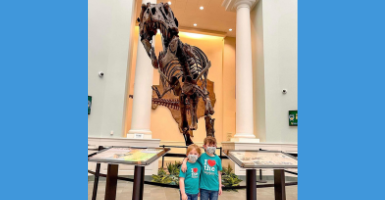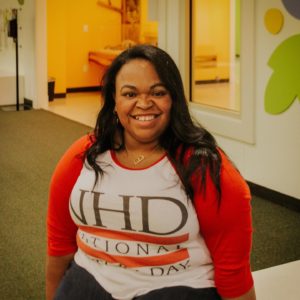June 13, 2022 / News & Blog

| This article is part of the “Communications 2022” issue of Hand to Hand. Click here to read other articles in the issue. |
By Rebecca Tucker Nall and Molly Noah, Mayborn Museum Complex
Children’s museums are in a unique position on social media.
Our direct audience is not there.
How do we communicate our museum’s value and create a robust online community? Let’s talk about how children’s museums can successfully advocate for their experiences and build a strong social community with their indirect audience—parents.
At the Mayborn Museum Complex at Baylor University in Waco, Texas, we use storytelling techniques to encourage parents to choose the museum as a resource to supplement learning and fuel a love of science. Our storytelling begins with our brand values—creativity, curiosity, and collaboration—and then considers our audience’s needs.
Attracting the attention of potential visitors on social media is a privilege, and museums must earn that to create genuine trust and credibility. But who are they? Everything starts with research. At the Mayborn, we dig into who our audience is and is not. Through our participation in ASTC’s COVES initiative (astc.org/impact-initiatives/coves/), we know a fair bit about who walks through our doors—and how our experience resonates with them. For example, we know our audience is composed of mostly college-educated, young families who want high-quality experiences and the opportunity to learn something new. For our digital visitors (anyone who visits our website, social channels, or opens an email), we study user analytics and in-app insights to create user profiles. After exhaustive research, we know who they are and that they want safe, hands-on, and awe-inspiring experiences for their family—oh, and a new experience each time they visit! Now that we know their needs, we can create social media content that we think they want.
Mayborn Museum is the leading center for youth science and education in Central Texas. While some members of our community remain skeptical of science, everyone can relate to our brand values of creativity, curiosity, and collaboration. When visitors walk through our doors, fact-based science is presented with a sense of wonder. We recreate that same sense of wonder and trust on all of our marketing materials, including each of our social channels. We want the audience to see us as the place to be if they want their kids to be creators, inventors, makers, or researchers.
One of my favorite sayings is, “information comes in casual conversation.” Children’s museums can package their brand values and marketing messages while also meeting their audience’s needs by creating original content around something people are already talking about—other people’s stories.
Black History Month, one of the most important months of the year, offers an incredible opportunity to tell the stories of the contributions of Black Americans to science and museums. While our institution had in-person engagement opportunities focused on Black history throughout the month, our marketing team took the opportunity to feature local, Black scientists and museum professionals who embody our museum’s values like curiosity and collaboration on our social media channels. We brought them to the museum for a tour and an informal photoshoot, building content that would go in our newsletter and on all our social platforms including Twitter, Facebook, Instagram, and LinkedIn.
We met Dr. Bessie Kebaara, a scientist who believes yeast holds the key to understanding human RNA, in 2021 when she went through our Portal to the Public program, an Institute for Learning Innovation collaboration that connects our audiences with current science through conversations with Baylor University scientists. Normally Dr. Kebaara would bring her yeast canisters and research presentation to the museum and catch wandering visitors for a quick talk about RNA’s transformational qualities. But for Black History Month, we invited her to come to the museum for a photoshoot and an informal interview. We wanted to hear about her work and what drove her to become a scientist, in the hope that she could inspire future scientists here in Central Texas. You can read her interview here.
Brandice Nelson is a public historian and the Director of Engagement at National History Day, a nonprofit that engages middle- and high-school students around the world in conducting original research on historical topics of interest. Nelson graduated from the Mayborn’s Museum Studies program in 2016 and now lives between Waco and Austin, Texas. We invited Nelson to “take over” our social media accounts to show a day in her life. She walked our audience through her morning routine, said hello to her hamster, and watched her prepare for a big National History Day Fair coming up soon. Our audience caught a glimpse into life as a public historian. You can view her takeover in our Instagram story highlight “Brandice Nelson” on our Instagram profile.

Public historian Brandice Nelson invited our social media audience to walk through her day as she prepares for the National History Day fair.
We’re grateful to Dr. Kebaara and Brandice Nelson for sharing a bit about their lives with our audience, and we hope their stories inspired Central Texas parents to bring their children to the museum to explore a career in science or history. We found success through embedding our science content in stories about real people. These features received double the organic reach of our regular posts and triple the shares! Shares are the incredible currency on social: they tell you who is connecting to your content while also signaling to the algorithms that this is high-quality content. The higher quality of the post, the higher it will rank in the feeds. Now we have more eyeballs on our museum—and our mission! While social media algorithms change, one thing does not, and that is the value of time. Each app wants the audience’s eyeball for as long as possible and they will reward creators who can keep an audience for a long session.
One of my favorite marketers, Allie Wassum, global director, social & integrated media at Jordan (Nike) said, “In paid social, you make a brand promise. In organic, you deliver on it.” If you work in social, then you know that organic reach is disappearing on Facebook and Instagram. Hashtags are questionable in efficacy, and the algorithms change all the time. It is challenging work to stay in front of your audience. We keep a targeted, paid ad on our social channels to make sure we stay in front of the right audience. Our paid ads are visual reminders of the value of a Mayborn experience and always include a powerful call to action. In our ad below, we show two children embracing in front of our T. rex, Stan, with their t-shirts saying, “I love the Mayborn.”
We attracted more than 3,000 new followers during our paid campaigns in November and December 2021. Once you follow us, we make a promise that the stories we are telling are worth your time—brand marketing married with awareness. Our social channels are a place you can spend a lot of time. This is a good thing, because social media algorithms prioritize your content based on how much time people spend looking at it.
Parents do not follow museums on social media so they can see our calendars of events or exhibit upgrades. They follow us to be entertained, educated, and learn how to spend quality time with their family. Developing original, creative storytelling may seem time-consuming, but investing time and social real estate in original content is where you deliver on the promise you made in your paid advertising. It’s a powerful one-two combination. We know that people are hungry to build a real community online. Through powerful storytelling, children’s museums can be part of that online community while successfully advocating for their experiences.
Rebecca Tucker Nall, currently assistant director of exhibits, communication, and visitor services at the Mayborn Museum Complex in Waco, Texas, has served in various roles at the Mayborn since 2007, overseeing the museum’s marketing and front-of-house staff for the last five years.
Molly Noah is the marketing coordinator at the Mayborn Museum Complex. With a bachelor’s degree in anthropology and master’s degree in museum science, she has been working in social media within the museum field for the past four years.